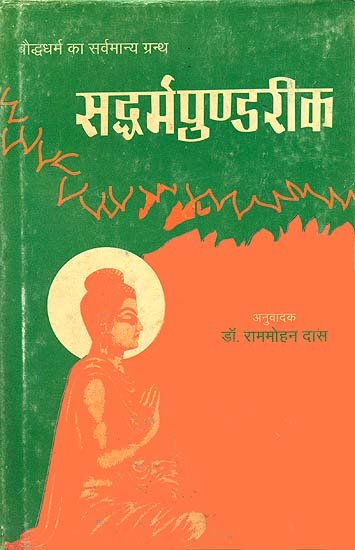Lotus Sutra (Saddharma-Pundarika) [sanskrit]
by H. Kern | 2013 | 16,351 words | ISBN-13: 9788120801226
The Lotus Sutra (Saddharma-pundarika) is an important Mahayana Buddhist scripture classified as one of the nine Dharmas. the Lotus Sutra deals with a wide range of important Buddhist teachings in twenty-seven chapters including the nature of the Buddhas and the inherent potentiality of becoming Buddha within all beings. This editions only contains the Sanskrit metrical text and the corresponding English translation. Alternative titles: Saddharma-puṇḍarīka-sūtra (सद्धर्म-पुण्डरीक-सूत्र).
Verse 10.32
तहिं च स्य विहरतो एकस्य वनचारिणः ।
देवान् यक्षांश्च प्रेषिष्ये सहायांस्तस्य नैकशः ॥ ३२ ॥
tahiṃ ca sya viharato ekasya vanacāriṇaḥ |
devān yakṣāṃśca preṣiṣye sahāyāṃstasya naikaśaḥ || 32 ||
While he is living lonely in the wilderness, I will send him gods and goblins in great number to keep him company.
English translation by H. Kern (2013) Buy now!
Glossary of Sanskrit terms
Note: This extracts Sanskrit terms and links to English definitions from the glossary, based on an experimental segmentation of verse (10.32). Some terms could be superfluous while some might not be mentioned. Click on the word to show English definitions.
Sya, Eka, Vanacarin, Vanacari, Deva, Yaksha, Sahaya, Tad, Naikashah,
Analysis of Sanskrit grammar
Note: this is an experimental feature and only shows the first possible analysis of the Sanskrit text (Lotus Sutra Verse 10.32). If the system was successful in segmenting the sentence, you will see of which words it is made up of, generally consisting of Nouns, Pronouns, Verbs, Participles and Indeclinables. Click on the link to show all possible derivations of the word.
- Line 1: “tahiṃ ca sya viharato ekasya vanacāriṇaḥ ”
- Cannot analyse tahim*ca
- ca -
-
ca (indeclinable conjunction)[indeclinable conjunction]ca (noun, masculine)[compound], [vocative single]ca (noun, neuter)[compound], [vocative single]
- sya -
-
sya (noun, neuter)[compound], [vocative single]sya (noun, masculine)[nominative single]√sā (verb class 4)[imperative active second single]
- viharato -
-
- ekasya -
-
eka (noun, masculine)[genitive single]eka (noun, neuter)[genitive single]
- vanacāriṇaḥ -
-
vanacārin (noun, masculine)[nominative plural], [vocative plural], [accusative plural], [ablative single], [genitive single]vanacārin (noun, neuter)[ablative single], [genitive single]vanacārī (noun, neuter)[ablative single], [genitive single]
- Line 2: “devān yakṣāṃśca preṣiṣye sahāyāṃstasya naikaśaḥ ”
- devān -
-
deva (noun, masculine)[accusative plural]
- yakṣāṃś -
-
yakṣa (noun, masculine)[accusative plural]
- ca -
-
ca (indeclinable conjunction)[indeclinable conjunction]ca (noun, masculine)[compound], [vocative single]ca (noun, neuter)[compound], [vocative single]
- preṣiṣye -
-
√preṣ (verb class 1)[future middle first single]
- sahāyāṃs -
-
sahāya (noun, masculine)[accusative plural]
- tasya -
-
√tas -> tasya (absolutive)[absolutive from √tas]ta (noun, masculine)[genitive single]ta (noun, neuter)[genitive single]tad (noun, neuter)[genitive single]sa (noun, masculine)[genitive single]√tas (verb class 4)[imperative active second single]
- naikaśaḥ -
-
naikaśaḥ (indeclinable)[indeclinable]
Other editions:
Also see the following editions of the Sanskrit text or (alternative) English translations of the Lotus Sutra Verse 10.32
The Lotus Sutra (The Saddharma-Pundarika)
by H. Kern (2013)
The Lotus Sutra (Text with Hindi Translation)
by Ram Mohan Das (2001)
![Lotus Sutra (Saddharma-Pundarika) [sanskrit] - book cover](/uploads/a/Lotus-Sutra.jpg)
